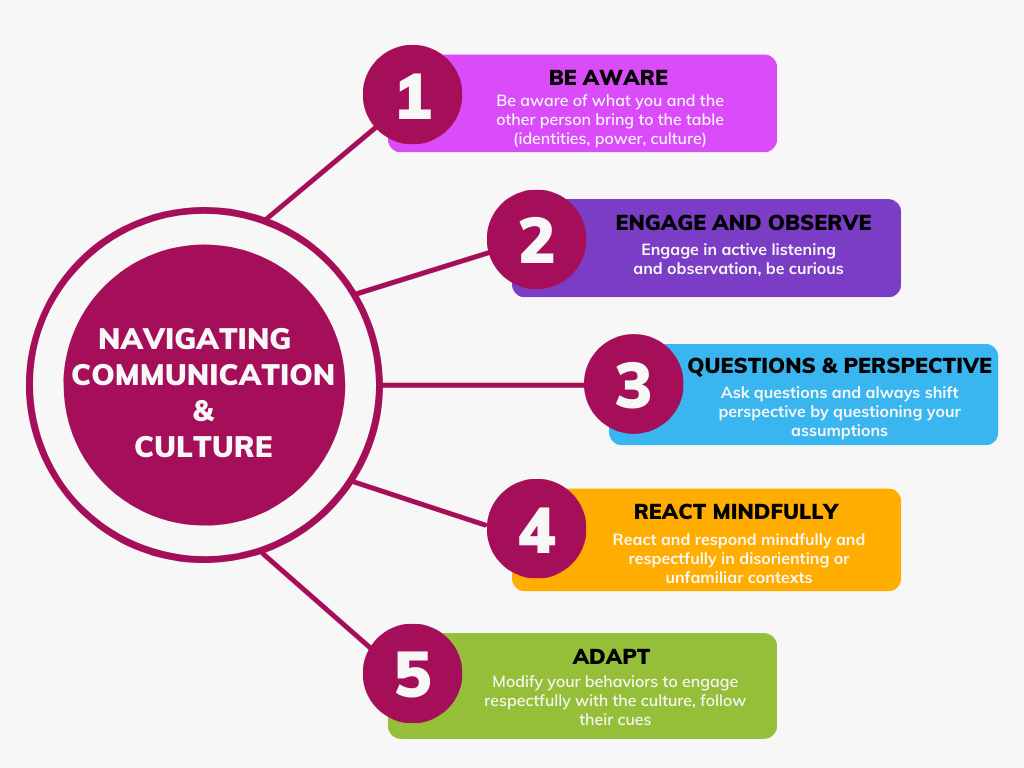So how do we bridge these gaps of understanding?

At the heart of it all is also effective intercultural communication
Intercultural communication = seeks to understand how people from different countries and cultures act, communicate, and perceive the world around them.
Below are 8 strategies for intercultural communication (click on each tab to read why/how each one is important). Later in this training, you will learn more about specific norms of Balinese culture, but below are general guidelines for any cultural interactions.
1. Maintain respectful language and formality
Many cultures have specific etiquette around the way they communicate. Using formal language (if there is one) until the other person provides a cue to stop doing so ensures you do not offend others’ expectations of formality. Also avoid slang, as it is harder to understand. This is also the case with humor and sarcasm, since it can easily be misinterpreted.
2. Speak slowly
Even with English being a commonly spoken language, talking at a slightly slower pace (not your normal conversational speed) and pronouncing your words clearly is ideal. Short and digestible sentences are easier to translate. If you need it, you can also politely ask the other person to slow down too. However, DO NOT speak too slowly or look down on people, as this may be patronizing and imply you think they are incapable or unintelligent.
3. Simple is best
To ensure language doesn’t become a barrier, avoid using overly complicated or pretentious words. If communication becomes challenging, writing the words down can help (especially with numbers).
4. Practice active listening
Active listening, such as restating or summarizing what the other person has said, can ensure that you have understood them correctly. Asking frequent questions can also build relationships and avoid misunderstandings. Conversations also flow more freely through back and forth careful listening and response. Shorter exchanges (a few sentences rather than a monologue) will be easier to follow.
5. Body language
Body language includes everything from facial expressions, to personal space and eye contact. Generally, it’s important to note that among various cultures 1) norms around personal space vary, 2) the appropriateness of touching is viewed differently, 3) the meaning of eye contact may be different and 4) try to avoid hand gestures altogether as many are taboo.
6. Avoid closed questions
Closed questions (those with ‘yes’ or ‘no’ answers) are not always well accepted by all cultures, so asking open-ended questions (those that require information as a response) can help get more accurate answers. If someone does reply yes or no, you may want to be prepared with a backup question or way to rephrase. You’ll also learn more through longer discussions!
7. Be supportive
The most important thing about effective cross-cultural communication is that everyone feels comfortable. Respect and encouragement will help both sides build confidence and trust.
8. Language learning
Accumulating a small but basic conversational vocabulary in the local language is ideal because it allows you to create connections, ask questions, and it overall demonstrates that you are interested and making efforts to learn about people and their culture!
Case Example
Reflection 10: Respond to the following case example :Person A, from Australia, and Person B, from Bali, are having dinner together. Person B asks Person A how their trip to a nearby beach went. Person A had a lovely time but replies jokingly, “It was terrible! It was too beautiful!”. Person B frowns and asks what happened, worried.
- What happened in this interaction?
- How do you think Person A could have avoided this?
